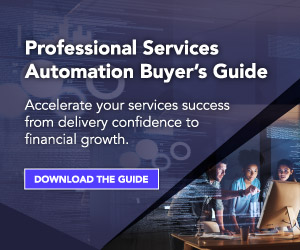
We are living in the age of consumerization in enterprise software. It is an age where usability and performance must go hand in hand. Regardless of how rich in feature and functionality software is, people will not use it if they cannot grasp it quickly. In fact, a recent Forbes article stated a simplified user experience as one of top signs a new tech product will make a positive impact.
However, the solution is not easy. There is a fine line to walk. With the “consumerization of IT”, oftentimes new, sleek looking user interfaces do not support the required enterprise-grade capabilities needed for the job. Services automation software providers understand this, as product leaders continue to focus heavily on enhancing user experience, while maintaining a robust enterprise-grade offering.
Professional services automation is an intricate process with a lot of moving parts. Oftentimes it is more of an art than science, centered around achieving profitable work velocity based on tight contractual terms. Services leaders must forecast, align human capital, manage billing and invoicing, and recognize revenue to achieve success. For example, regarding utilization, managers should be able to easily see how well billable resources are tracking to monthly targets. An intuitive user experience is critical here; if the software designed to manage this aspect of the “quote-to-cash” lifecycle is not intuitive; services leaders will struggle to bill accurately and deliver profitably. Depending on your business, there are other data points you’ll need to understand as well, such as:
- Total forecast revenue
- Current billable utilization
- Revenue by project manager
- Client satisfaction
Creating the ability to share financial elements like these in ways that delights specific users does not happen overnight. Instead, it requires a well thought out UX strategy deployed incrementally. The recent release of Changepoint SA 2020 is predicated on such; it is a step-by-step approach that merges deep, rich services automation feature and functionality with a customizable, intuitive user interface.
One key step is navigation. Navigation is critical to how users get from point A to point B, with the least amount of friction. Changepoint SA 2020 features a new top navigation. The objective is to surface the project KPIs in once place. In the KPIs snapshot example below, the information is grouped in a simple, recognizable way along with language that reflects various tasks making up an enterprise services leaders’ day-to-day such as Project, Resource, Finance, and more.
Professional services automation software’s navigation also needs to make accessing, searching, and finding key project information easy. If that information is missed, you start losing money. For example, you are suddenly at month’s end. Invoices are due and you are estimating how many billable hours were worked over the last week. An underestimation means revenue is left on the table and profitability suffers.

With ‘My Tools’ in Changepoint SA, you can drill further into complex project data.
In addition, there are new search capabilities including Global Search, Knowledge Search or Support Search, which all solve the number one cause of services leadership stress – the problem of missing project information, particularly the data that impacts the bottom line.
Ultimately, user experience impacts whether people adopt your product and effectively implement it to drive successful services delivery. To learn more, request a demo of Changepoint SA to experience the new navigation and more integral design enhancements.
Scott Mitchell is Product Marketing Manager for Changepoint Services Automation – software that extends traditional project management capabilities with functionality designed specifically to address the financial aspects of the business. Scott has spent 8 years working in the enterprise information management, workflow automation, speech analytics and mobile technology spaces. His day-to-day comprises of owning product success in the areas market research, positioning and messaging, go-to-market strategy, pipeline development and management, sales enablement and much more. In his free time, Scott likes to work out, tend to home projects, run along his hometown’s downtown waterfront and read nonfiction books.




